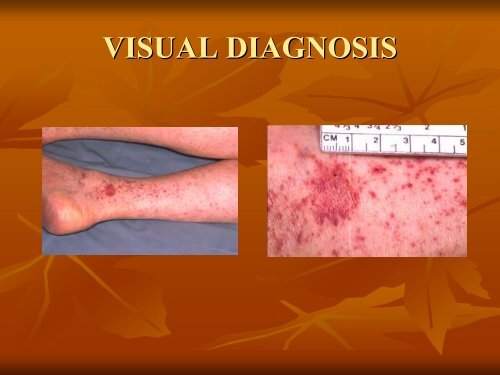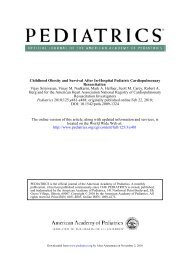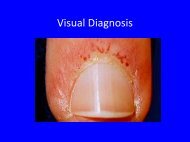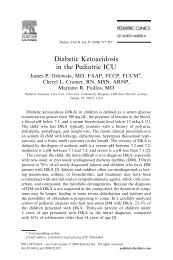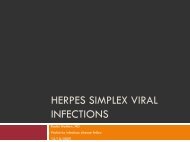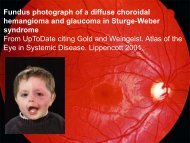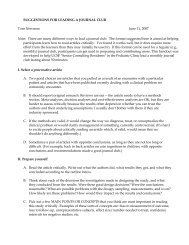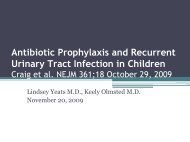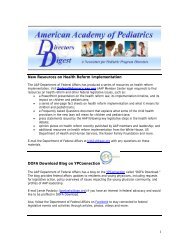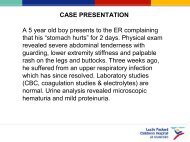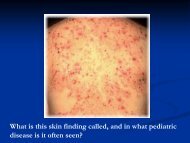VISUAL DIAGNOSIS VISUAL DIAGNOSIS
VISUAL DIAGNOSIS VISUAL DIAGNOSIS
VISUAL DIAGNOSIS VISUAL DIAGNOSIS
Create successful ePaper yourself
Turn your PDF publications into a flip-book with our unique Google optimized e-Paper software.
<strong>VISUAL</strong> <strong>DIAGNOSIS</strong>
A “ spidery ” rash<br />
Lindsay Jackson, MD<br />
October 14, 2009
Case of a “spidery “ spidery” ” rash<br />
3 year old male develops a spidery rash over<br />
the past week on his arms and legs<br />
3 year old male develops a spidery rash over<br />
Bruising noted over lower extremities<br />
Dried blood noted at ears, nose<br />
“Blood “ Blood blister” blister ” on lower lip
Purpura
The “spidery “ spidery” ” rash
Exam<br />
Growth parameters and vital signs normal<br />
Well appearing<br />
HEENT: ecchymosis over left eye, crusted<br />
blood in nares, palatal petechiae<br />
HEENT: ecchymosis over left eye, crusted<br />
Abdomen: no hepatosplenomegaly<br />
Skin: petechiae on arms, back, legs. Pretibial<br />
bruising<br />
Skin: petechiae on arms, back, legs. Pretibial
Differential Diagnosis<br />
What causes thrombocytopenia (platelet count<br />
below 150,000) in children?<br />
What causes thrombocytopenia (platelet count<br />
Idiopathic thrombocytopenic purpura<br />
Drug induced thrombocytopenia (heparin)<br />
TTP<br />
Sepsis/DIC<br />
Congenital<br />
TAR (Thrombocytopenia, absent radii)<br />
Kasabach Kasabach Merritt Merritt<br />
Wiskott Wiskott Aldrich Aldrich
Labs<br />
WBC 7.3 (29% neutrophils, 63% lymphocytes,<br />
6% monocytes, 2% eosinophils)<br />
WBC 7.3 (29% neutrophils, 63% lymphocytes,<br />
Hemoglobin 11.9 with Hematocrit 34.4<br />
Platelet count 2000<br />
Chemistry panel<br />
Chemistry panel<br />
Na 132, K 5.6 (Hemolyzed) and LDH 473<br />
Liver function studies normal
Figure 2. Peripheral smear in a patient with ITP showing an almost total absence of platelets<br />
Lazarchick, J. ASH Image Bank 2001;2001:100177<br />
Copyright ©2001 American Society of Hematology. Copyright restrictions may apply.
Idiopathic Thrombocytopenic<br />
Objectives<br />
Purpura (ITP)<br />
Objectives<br />
Know function and life span of platelets<br />
Describe the usual presentation and laboratory<br />
tests in the child with ITP<br />
Describe the usual presentation and laboratory<br />
Review the treatment options<br />
Know the usual prognosis
Normal peripheral smear<br />
Normal platelets are one fifth the<br />
diameter of erythrocytes.<br />
They survive in the body for 9 to 10<br />
days
Idiopathic Thrombocytopenic<br />
Purpura (ITP)<br />
Estimated to be one of the most common<br />
acquired bleeding disorders encountered by<br />
pediatricians<br />
Estimated to be one of the most common<br />
3 to 8 cases per 100,000 children per year<br />
3 to 8 cases per 100,000 children per year<br />
A general pediatrician can care for most<br />
children with ITP<br />
A general pediatrician can care for most
ITP<br />
Autoantibodies (usually IgG) are directed against<br />
platelet membrane antigens<br />
Autoantibodies (usually IgG) are directed against<br />
Antibody Antibody coated coated platelets have a shortened half half life life<br />
because of accelerated clearance by tissue<br />
macrophages in the spleen and other portions of the<br />
reticuloendothelial system.<br />
The net effect is a decrease in the platelet count.
IgG coated Platelets
Presentation<br />
Most common in ages 2 to 5<br />
Characterized by the sudden appearance of<br />
bruising/bleeding/petechiae in an otherwise<br />
healthy child<br />
Characterized by the sudden appearance of<br />
Association with prior infection<br />
Association with MMR vaccination
Petechiae in ITP
Pertinent Negatives<br />
No systemic symptoms<br />
Absence of lymphadenopathy and<br />
hepatosplenomegaly on exam<br />
No evidence of hemolysis<br />
Absence of lymphadenopathy and<br />
No evidence of hemolysis
Laboratory findings<br />
Platelet count typically below 30,000<br />
15% of patients will have mild anemia due to<br />
bleeding<br />
Essential to review peripheral smear<br />
15% of patients will have mild anemia due to<br />
Essential to review peripheral smear<br />
Large platelets
Leukemia<br />
Leukemia<br />
What do parents fear?<br />
In one study of 2239 patients with newly<br />
diagnosed ALL, NONE exhibited isolated<br />
thrombocytopenia<br />
Bone marrow examination not necessary in routine<br />
cases<br />
In one study of 2239 patients with newly<br />
Bone marrow examination not necessary in routine<br />
Dubansky AS, Boyett JM, Falletta J, et al: Isolated thrombocytopenia thrombocytop enia in children with<br />
acute lymphoblastic leukemia: A rare event in a Pediatric Oncology Oncolo gy Group study.<br />
Pediatrics 1986;77:49
Chronic ITP<br />
Thrombocytopenia lasting longer than 6<br />
months<br />
Thrombocytopenia lasting longer than 6<br />
Thyroid studies<br />
Thyroid studies<br />
ANA<br />
Coombs test<br />
HIV/CMV/EBV<br />
Immunodeficiency
Pharmacologic Therapy<br />
70 to 80 percent of children with ITP will recover<br />
within a few months of presentation with or without<br />
treatment<br />
70 to 80 percent of children with ITP will recover<br />
Most patients do not have serious bleeding including<br />
those with platelet counts
Pharmacologic therapy<br />
IVIG<br />
Steroids<br />
Anti Anti Rh(D) Rh(D) (Win Rho)<br />
Splenectomy
Patient follow up<br />
Patient admitted overnight and given IVIG<br />
Platelet count after IVIG increased to 97,000<br />
Discharged with a note for preschool (activity<br />
restriction)<br />
Discharged with a note for preschool (activity<br />
Instructed to avoid aspirin, NSAIDS
Platelet counts<br />
Patient Follow Up<br />
Platelet counts<br />
2,000 (admit June 6, 2008)<br />
97,000 (June 10)<br />
67,000 (June 24)<br />
25,000 (July 11)<br />
70,000 (August 8)<br />
140, 000 (October 14)<br />
472,000 (January 29, 2009)
Questions?<br />
Free YOGA class tonight!<br />
6:15pm, Third floor LPCH in the<br />
physical therapy rooms (near the<br />
MD workroom just off 3 South)<br />
Thank you Mark Halpert for<br />
teaching!
References<br />
Steuber, C. Treatment and prognosis of immune<br />
(idiopathic) thrombocytopenic purpura in children.<br />
UpToDate online.<br />
Buchanan, G. Thrombocytopenia During Childhood.<br />
Pediatrics in Review 2005;26:401<br />
2005;26:401 409 409<br />
Chu, Y et all. Itopathic Thrombocytopenic Purpura.<br />
Pediatrics in Review 2000;21:95 2000;21:95 101 101<br />
Buchanan, G. ITP: How much treatment is enough?<br />
Contemporary Pediatrics 2000;14: 112 112 121 121<br />
Steuber, C. Treatment and prognosis of immune<br />
Buchanan, G. Thrombocytopenia During Childhood.<br />
Chu, Y et all. Itopathic Thrombocytopenic Purpura.<br />
Buchanan, G. ITP: How much treatment is enough?


